Chairing Meetings and Recording Minutes for Effective Communication
VerifiedAdded on 2023/06/10
|13
|3501
|252
AI Summary
This article provides guidance on chairing meetings, developing agendas, recording minutes, and resolving conflicts. It covers the skills and knowledge required for effective communication and provides tips on how to conduct successful meetings and communicate outcomes. The article also includes sample agendas and meeting procedures.
Contribute Materials
Your contribution can guide someone’s learning journey. Share your
documents today.
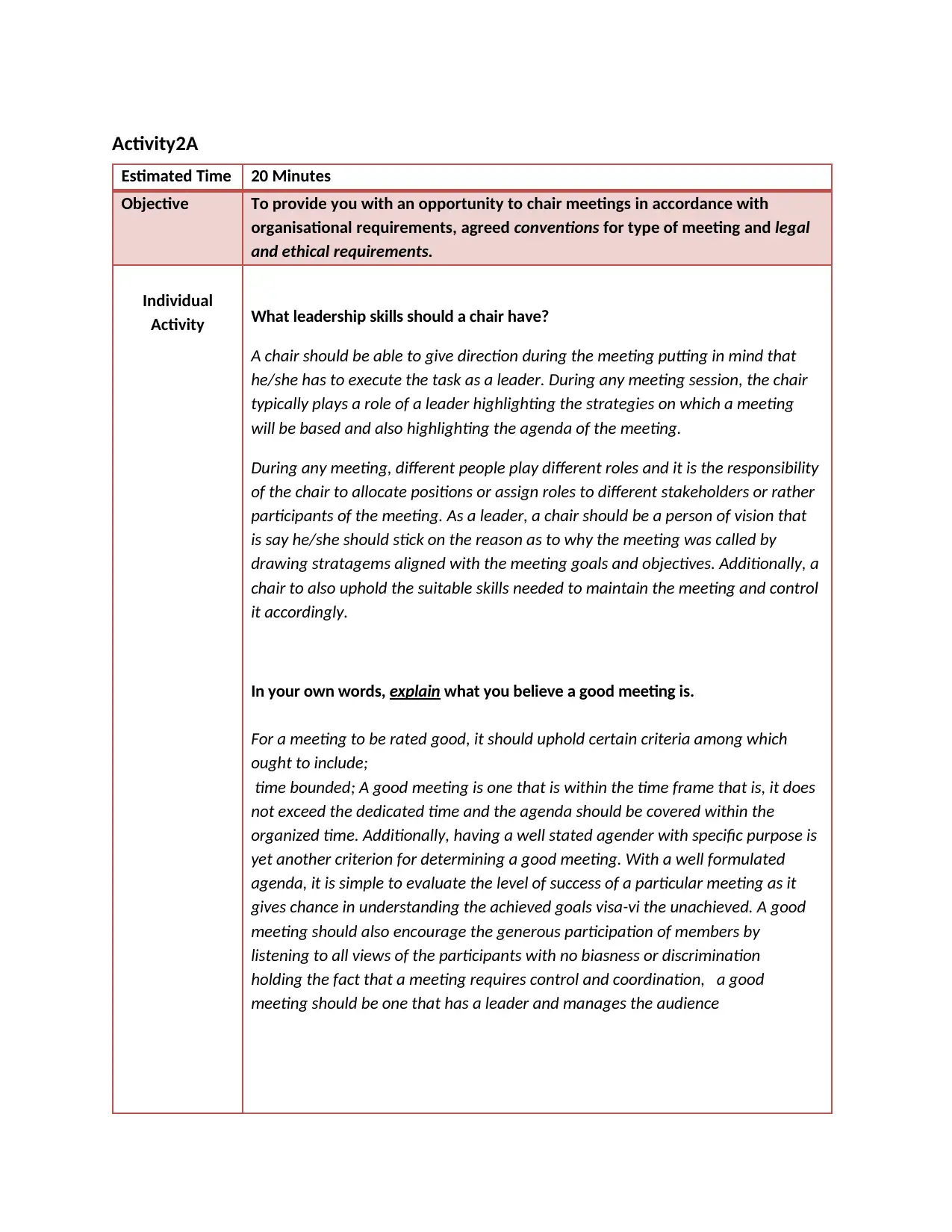
Activity2A
Estimated Time 20 Minutes
Objective To provide you with an opportunity to chair meetings in accordance with
organisational requirements, agreed conventions for type of meeting and legal
and ethical requirements.
Individual
Activity What leadership skills should a chair have?
A chair should be able to give direction during the meeting putting in mind that
he/she has to execute the task as a leader. During any meeting session, the chair
typically plays a role of a leader highlighting the strategies on which a meeting
will be based and also highlighting the agenda of the meeting.
During any meeting, different people play different roles and it is the responsibility
of the chair to allocate positions or assign roles to different stakeholders or rather
participants of the meeting. As a leader, a chair should be a person of vision that
is say he/she should stick on the reason as to why the meeting was called by
drawing stratagems aligned with the meeting goals and objectives. Additionally, a
chair to also uphold the suitable skills needed to maintain the meeting and control
it accordingly.
In your own words, explain what you believe a good meeting is.
For a meeting to be rated good, it should uphold certain criteria among which
ought to include;
time bounded; A good meeting is one that is within the time frame that is, it does
not exceed the dedicated time and the agenda should be covered within the
organized time. Additionally, having a well stated agender with specific purpose is
yet another criterion for determining a good meeting. With a well formulated
agenda, it is simple to evaluate the level of success of a particular meeting as it
gives chance in understanding the achieved goals visa-vi the unachieved. A good
meeting should also encourage the generous participation of members by
listening to all views of the participants with no biasness or discrimination
holding the fact that a meeting requires control and coordination, a good
meeting should be one that has a leader and manages the audience
Estimated Time 20 Minutes
Objective To provide you with an opportunity to chair meetings in accordance with
organisational requirements, agreed conventions for type of meeting and legal
and ethical requirements.
Individual
Activity What leadership skills should a chair have?
A chair should be able to give direction during the meeting putting in mind that
he/she has to execute the task as a leader. During any meeting session, the chair
typically plays a role of a leader highlighting the strategies on which a meeting
will be based and also highlighting the agenda of the meeting.
During any meeting, different people play different roles and it is the responsibility
of the chair to allocate positions or assign roles to different stakeholders or rather
participants of the meeting. As a leader, a chair should be a person of vision that
is say he/she should stick on the reason as to why the meeting was called by
drawing stratagems aligned with the meeting goals and objectives. Additionally, a
chair to also uphold the suitable skills needed to maintain the meeting and control
it accordingly.
In your own words, explain what you believe a good meeting is.
For a meeting to be rated good, it should uphold certain criteria among which
ought to include;
time bounded; A good meeting is one that is within the time frame that is, it does
not exceed the dedicated time and the agenda should be covered within the
organized time. Additionally, having a well stated agender with specific purpose is
yet another criterion for determining a good meeting. With a well formulated
agenda, it is simple to evaluate the level of success of a particular meeting as it
gives chance in understanding the achieved goals visa-vi the unachieved. A good
meeting should also encourage the generous participation of members by
listening to all views of the participants with no biasness or discrimination
holding the fact that a meeting requires control and coordination, a good
meeting should be one that has a leader and manages the audience
Secure Best Marks with AI Grader
Need help grading? Try our AI Grader for instant feedback on your assignments.
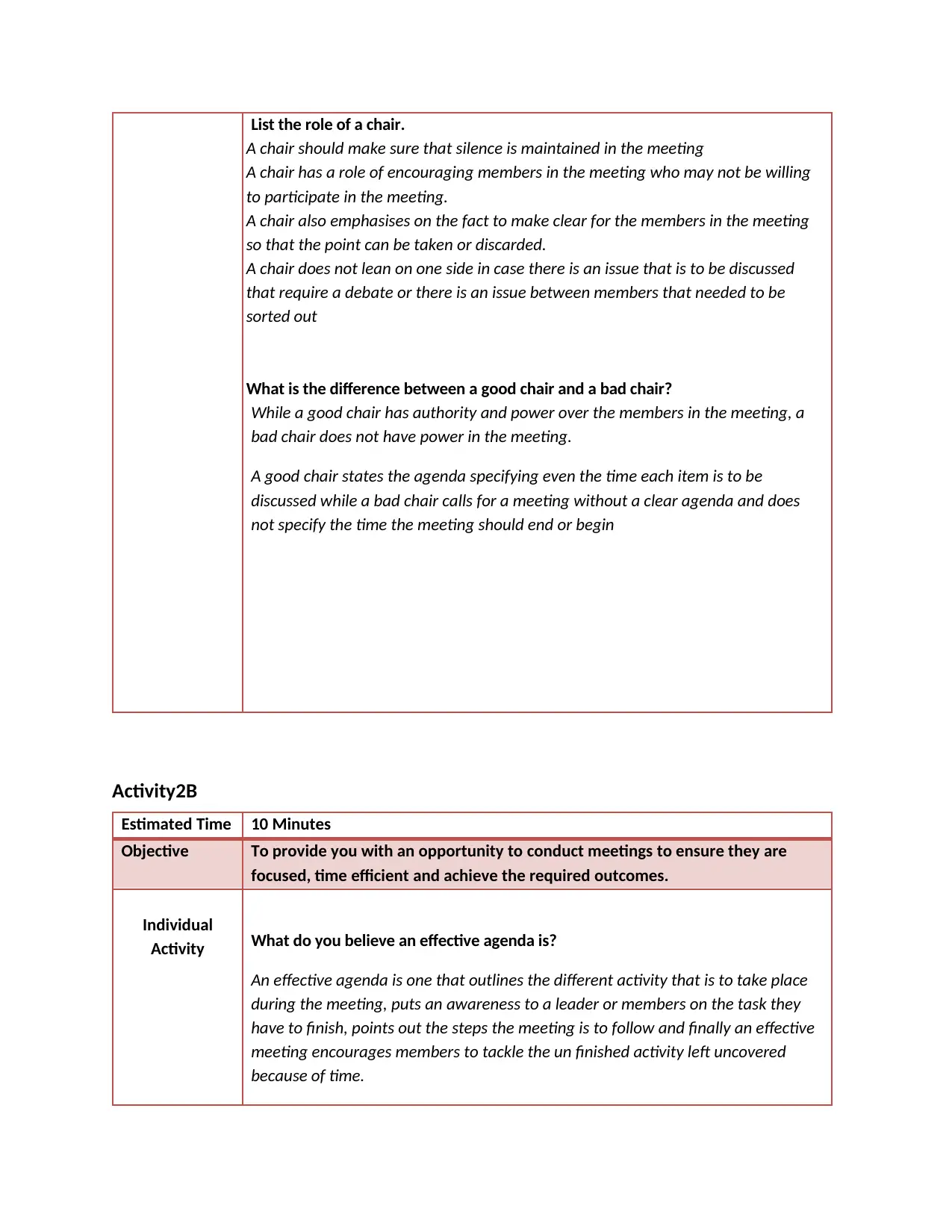
List the role of a chair.
A chair should make sure that silence is maintained in the meeting
A chair has a role of encouraging members in the meeting who may not be willing
to participate in the meeting.
A chair also emphasises on the fact to make clear for the members in the meeting
so that the point can be taken or discarded.
A chair does not lean on one side in case there is an issue that is to be discussed
that require a debate or there is an issue between members that needed to be
sorted out
What is the difference between a good chair and a bad chair?
While a good chair has authority and power over the members in the meeting, a
bad chair does not have power in the meeting.
A good chair states the agenda specifying even the time each item is to be
discussed while a bad chair calls for a meeting without a clear agenda and does
not specify the time the meeting should end or begin
Activity2B
Estimated Time 10 Minutes
Objective To provide you with an opportunity to conduct meetings to ensure they are
focused, time efficient and achieve the required outcomes.
Individual
Activity What do you believe an effective agenda is?
An effective agenda is one that outlines the different activity that is to take place
during the meeting, puts an awareness to a leader or members on the task they
have to finish, points out the steps the meeting is to follow and finally an effective
meeting encourages members to tackle the un finished activity left uncovered
because of time.
A chair should make sure that silence is maintained in the meeting
A chair has a role of encouraging members in the meeting who may not be willing
to participate in the meeting.
A chair also emphasises on the fact to make clear for the members in the meeting
so that the point can be taken or discarded.
A chair does not lean on one side in case there is an issue that is to be discussed
that require a debate or there is an issue between members that needed to be
sorted out
What is the difference between a good chair and a bad chair?
While a good chair has authority and power over the members in the meeting, a
bad chair does not have power in the meeting.
A good chair states the agenda specifying even the time each item is to be
discussed while a bad chair calls for a meeting without a clear agenda and does
not specify the time the meeting should end or begin
Activity2B
Estimated Time 10 Minutes
Objective To provide you with an opportunity to conduct meetings to ensure they are
focused, time efficient and achieve the required outcomes.
Individual
Activity What do you believe an effective agenda is?
An effective agenda is one that outlines the different activity that is to take place
during the meeting, puts an awareness to a leader or members on the task they
have to finish, points out the steps the meeting is to follow and finally an effective
meeting encourages members to tackle the un finished activity left uncovered
because of time.
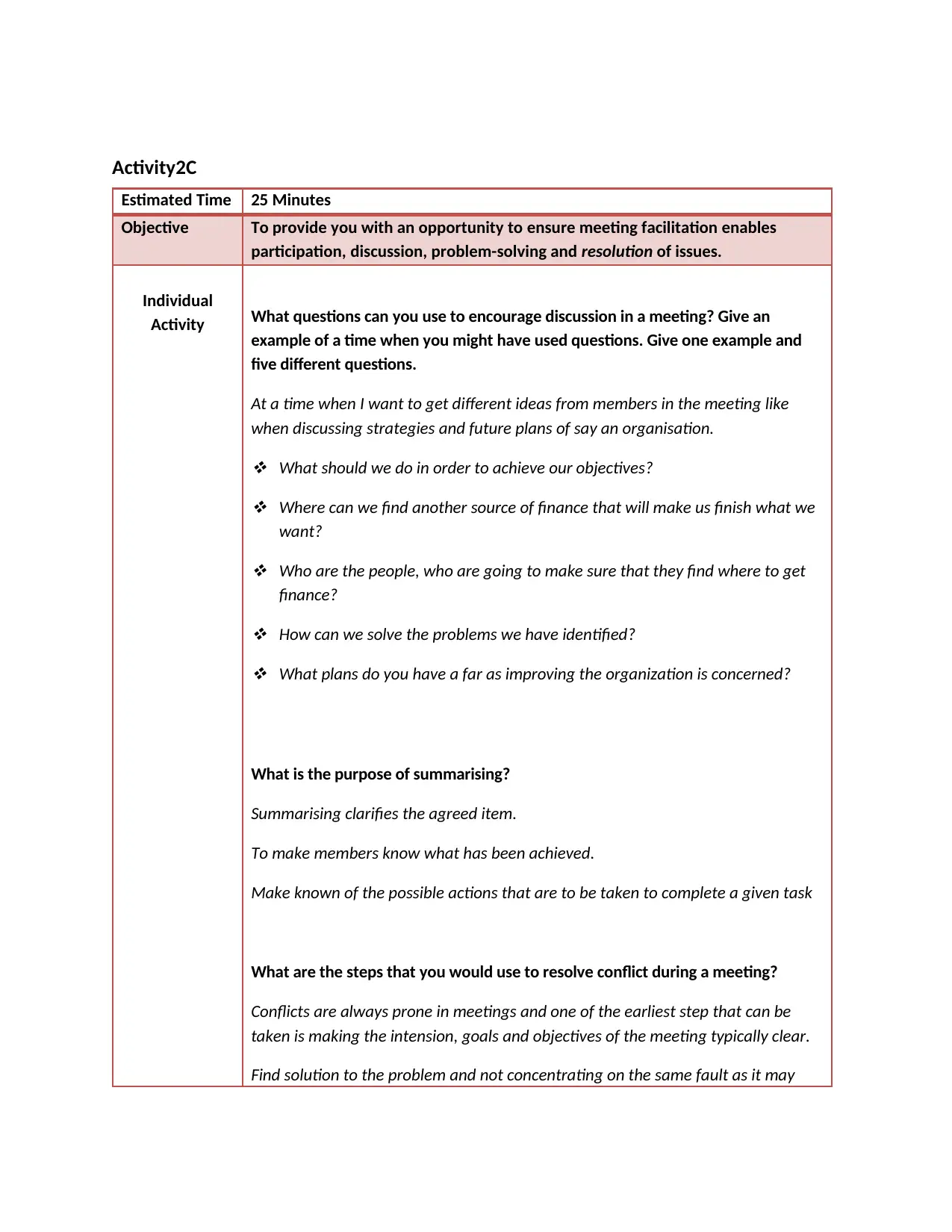
Activity2C
Estimated Time 25 Minutes
Objective To provide you with an opportunity to ensure meeting facilitation enables
participation, discussion, problem-solving and resolution of issues.
Individual
Activity What questions can you use to encourage discussion in a meeting? Give an
example of a time when you might have used questions. Give one example and
five different questions.
At a time when I want to get different ideas from members in the meeting like
when discussing strategies and future plans of say an organisation.
What should we do in order to achieve our objectives?
Where can we find another source of finance that will make us finish what we
want?
Who are the people, who are going to make sure that they find where to get
finance?
How can we solve the problems we have identified?
What plans do you have a far as improving the organization is concerned?
What is the purpose of summarising?
Summarising clarifies the agreed item.
To make members know what has been achieved.
Make known of the possible actions that are to be taken to complete a given task
What are the steps that you would use to resolve conflict during a meeting?
Conflicts are always prone in meetings and one of the earliest step that can be
taken is making the intension, goals and objectives of the meeting typically clear.
Find solution to the problem and not concentrating on the same fault as it may
Estimated Time 25 Minutes
Objective To provide you with an opportunity to ensure meeting facilitation enables
participation, discussion, problem-solving and resolution of issues.
Individual
Activity What questions can you use to encourage discussion in a meeting? Give an
example of a time when you might have used questions. Give one example and
five different questions.
At a time when I want to get different ideas from members in the meeting like
when discussing strategies and future plans of say an organisation.
What should we do in order to achieve our objectives?
Where can we find another source of finance that will make us finish what we
want?
Who are the people, who are going to make sure that they find where to get
finance?
How can we solve the problems we have identified?
What plans do you have a far as improving the organization is concerned?
What is the purpose of summarising?
Summarising clarifies the agreed item.
To make members know what has been achieved.
Make known of the possible actions that are to be taken to complete a given task
What are the steps that you would use to resolve conflict during a meeting?
Conflicts are always prone in meetings and one of the earliest step that can be
taken is making the intension, goals and objectives of the meeting typically clear.
Find solution to the problem and not concentrating on the same fault as it may
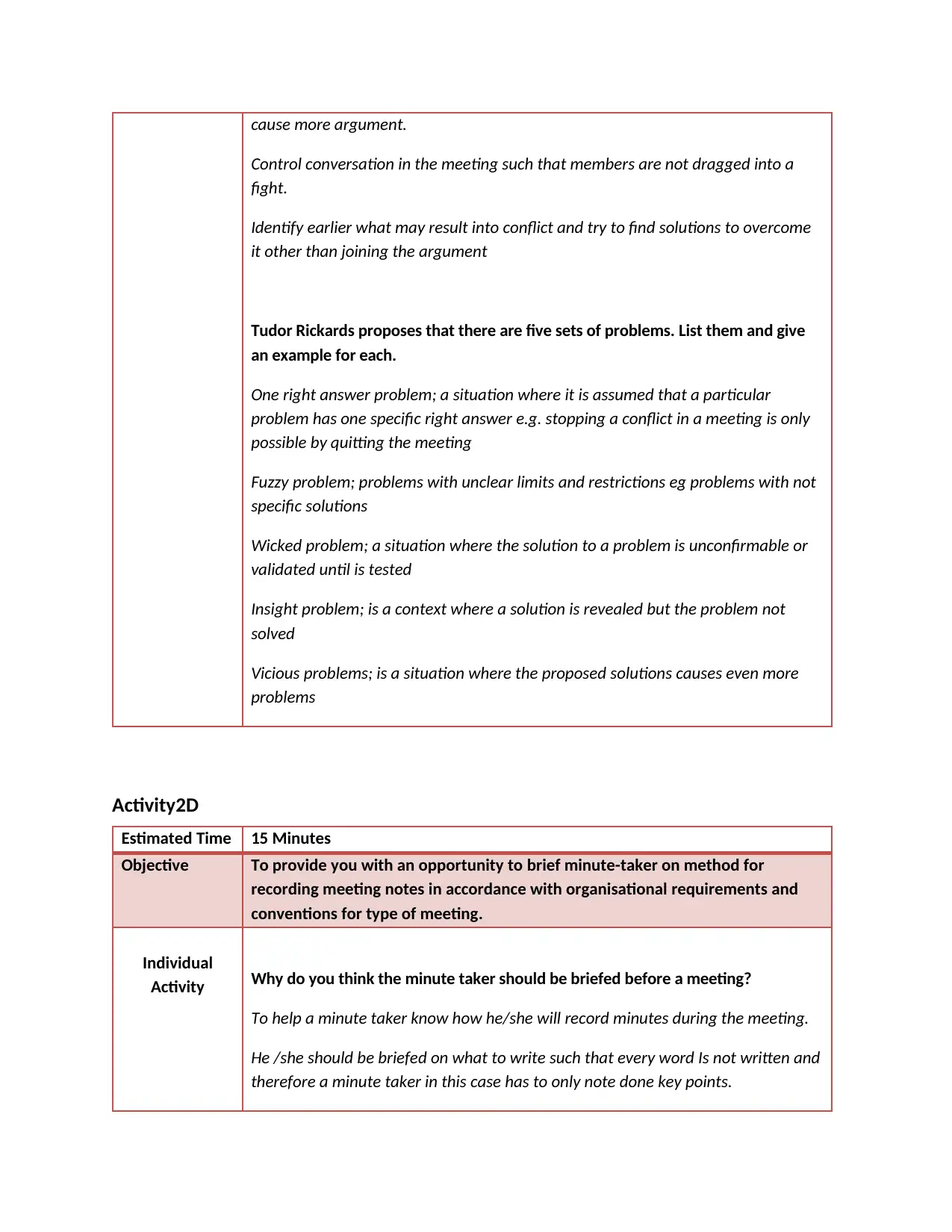
cause more argument.
Control conversation in the meeting such that members are not dragged into a
fight.
Identify earlier what may result into conflict and try to find solutions to overcome
it other than joining the argument
Tudor Rickards proposes that there are five sets of problems. List them and give
an example for each.
One right answer problem; a situation where it is assumed that a particular
problem has one specific right answer e.g. stopping a conflict in a meeting is only
possible by quitting the meeting
Fuzzy problem; problems with unclear limits and restrictions eg problems with not
specific solutions
Wicked problem; a situation where the solution to a problem is unconfirmable or
validated until is tested
Insight problem; is a context where a solution is revealed but the problem not
solved
Vicious problems; is a situation where the proposed solutions causes even more
problems
Activity2D
Estimated Time 15 Minutes
Objective To provide you with an opportunity to brief minute-taker on method for
recording meeting notes in accordance with organisational requirements and
conventions for type of meeting.
Individual
Activity Why do you think the minute taker should be briefed before a meeting?
To help a minute taker know how he/she will record minutes during the meeting.
He /she should be briefed on what to write such that every word Is not written and
therefore a minute taker in this case has to only note done key points.
Control conversation in the meeting such that members are not dragged into a
fight.
Identify earlier what may result into conflict and try to find solutions to overcome
it other than joining the argument
Tudor Rickards proposes that there are five sets of problems. List them and give
an example for each.
One right answer problem; a situation where it is assumed that a particular
problem has one specific right answer e.g. stopping a conflict in a meeting is only
possible by quitting the meeting
Fuzzy problem; problems with unclear limits and restrictions eg problems with not
specific solutions
Wicked problem; a situation where the solution to a problem is unconfirmable or
validated until is tested
Insight problem; is a context where a solution is revealed but the problem not
solved
Vicious problems; is a situation where the proposed solutions causes even more
problems
Activity2D
Estimated Time 15 Minutes
Objective To provide you with an opportunity to brief minute-taker on method for
recording meeting notes in accordance with organisational requirements and
conventions for type of meeting.
Individual
Activity Why do you think the minute taker should be briefed before a meeting?
To help a minute taker know how he/she will record minutes during the meeting.
He /she should be briefed on what to write such that every word Is not written and
therefore a minute taker in this case has to only note done key points.
Secure Best Marks with AI Grader
Need help grading? Try our AI Grader for instant feedback on your assignments.
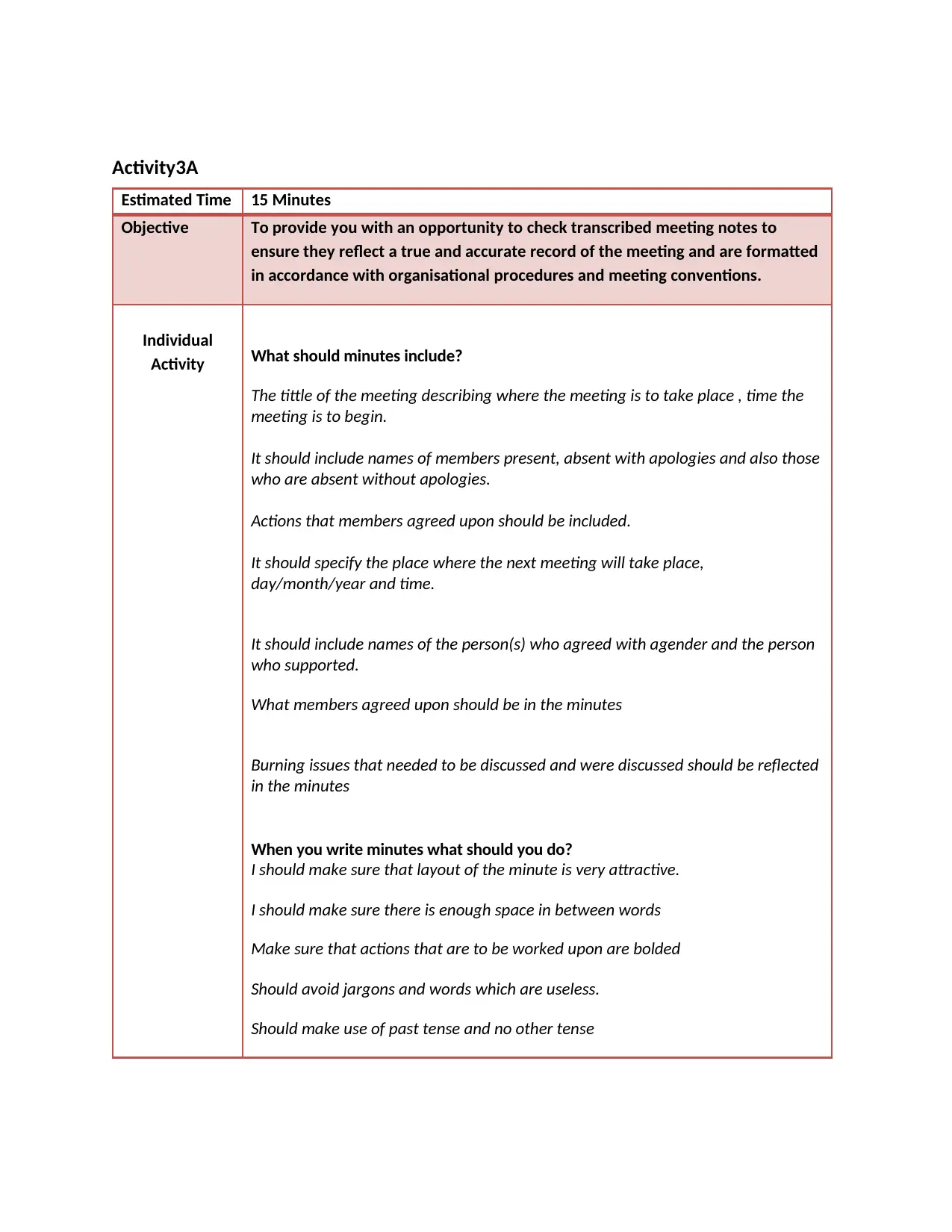
Activity3A
Estimated Time 15 Minutes
Objective To provide you with an opportunity to check transcribed meeting notes to
ensure they reflect a true and accurate record of the meeting and are formatted
in accordance with organisational procedures and meeting conventions.
Individual
Activity What should minutes include?
The tittle of the meeting describing where the meeting is to take place , time the
meeting is to begin.
It should include names of members present, absent with apologies and also those
who are absent without apologies.
Actions that members agreed upon should be included.
It should specify the place where the next meeting will take place,
day/month/year and time.
It should include names of the person(s) who agreed with agender and the person
who supported.
What members agreed upon should be in the minutes
Burning issues that needed to be discussed and were discussed should be reflected
in the minutes
When you write minutes what should you do?
I should make sure that layout of the minute is very attractive.
I should make sure there is enough space in between words
Make sure that actions that are to be worked upon are bolded
Should avoid jargons and words which are useless.
Should make use of past tense and no other tense
Estimated Time 15 Minutes
Objective To provide you with an opportunity to check transcribed meeting notes to
ensure they reflect a true and accurate record of the meeting and are formatted
in accordance with organisational procedures and meeting conventions.
Individual
Activity What should minutes include?
The tittle of the meeting describing where the meeting is to take place , time the
meeting is to begin.
It should include names of members present, absent with apologies and also those
who are absent without apologies.
Actions that members agreed upon should be included.
It should specify the place where the next meeting will take place,
day/month/year and time.
It should include names of the person(s) who agreed with agender and the person
who supported.
What members agreed upon should be in the minutes
Burning issues that needed to be discussed and were discussed should be reflected
in the minutes
When you write minutes what should you do?
I should make sure that layout of the minute is very attractive.
I should make sure there is enough space in between words
Make sure that actions that are to be worked upon are bolded
Should avoid jargons and words which are useless.
Should make use of past tense and no other tense
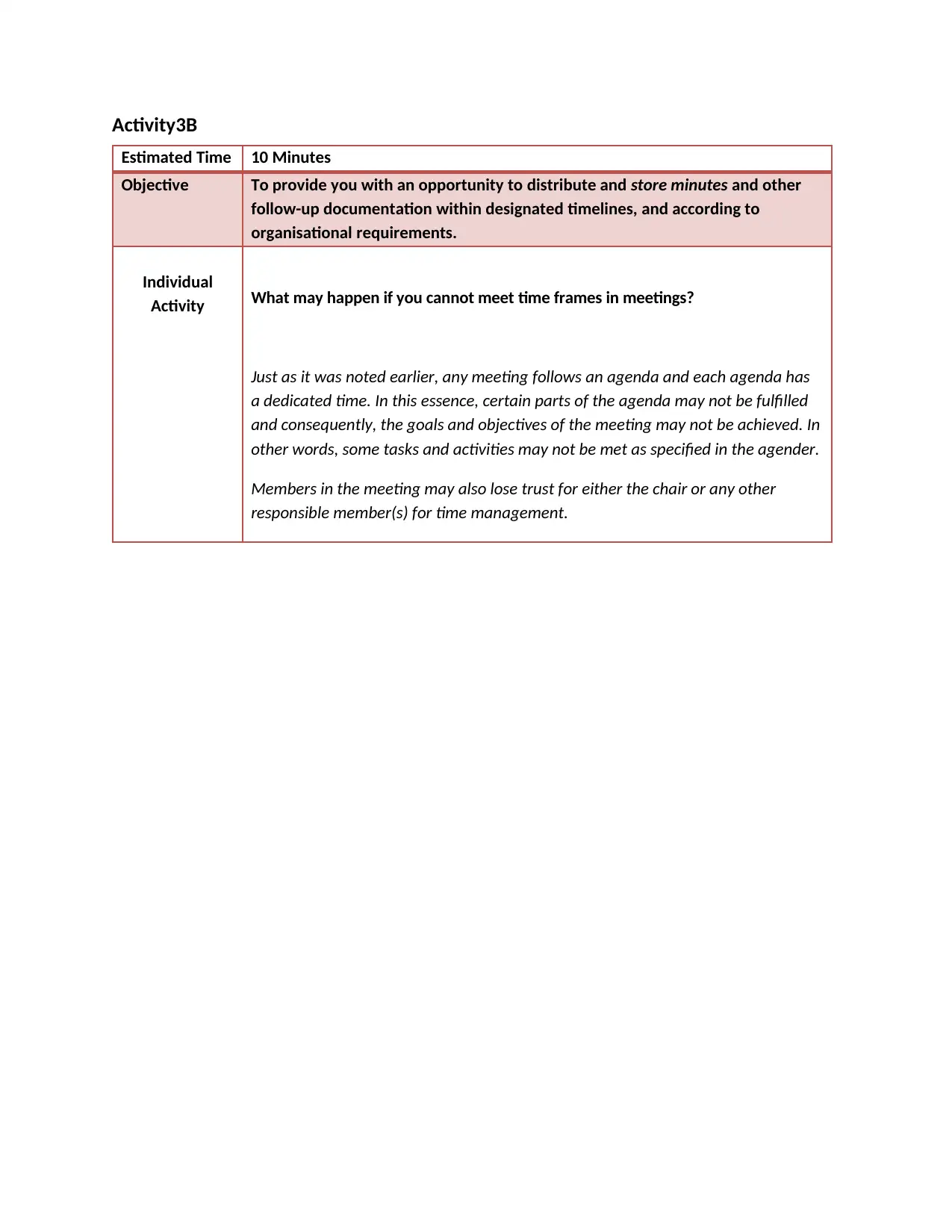
Activity3B
Estimated Time 10 Minutes
Objective To provide you with an opportunity to distribute and store minutes and other
follow-up documentation within designated timelines, and according to
organisational requirements.
Individual
Activity What may happen if you cannot meet time frames in meetings?
Just as it was noted earlier, any meeting follows an agenda and each agenda has
a dedicated time. In this essence, certain parts of the agenda may not be fulfilled
and consequently, the goals and objectives of the meeting may not be achieved. In
other words, some tasks and activities may not be met as specified in the agender.
Members in the meeting may also lose trust for either the chair or any other
responsible member(s) for time management.
Estimated Time 10 Minutes
Objective To provide you with an opportunity to distribute and store minutes and other
follow-up documentation within designated timelines, and according to
organisational requirements.
Individual
Activity What may happen if you cannot meet time frames in meetings?
Just as it was noted earlier, any meeting follows an agenda and each agenda has
a dedicated time. In this essence, certain parts of the agenda may not be fulfilled
and consequently, the goals and objectives of the meeting may not be achieved. In
other words, some tasks and activities may not be met as specified in the agender.
Members in the meeting may also lose trust for either the chair or any other
responsible member(s) for time management.
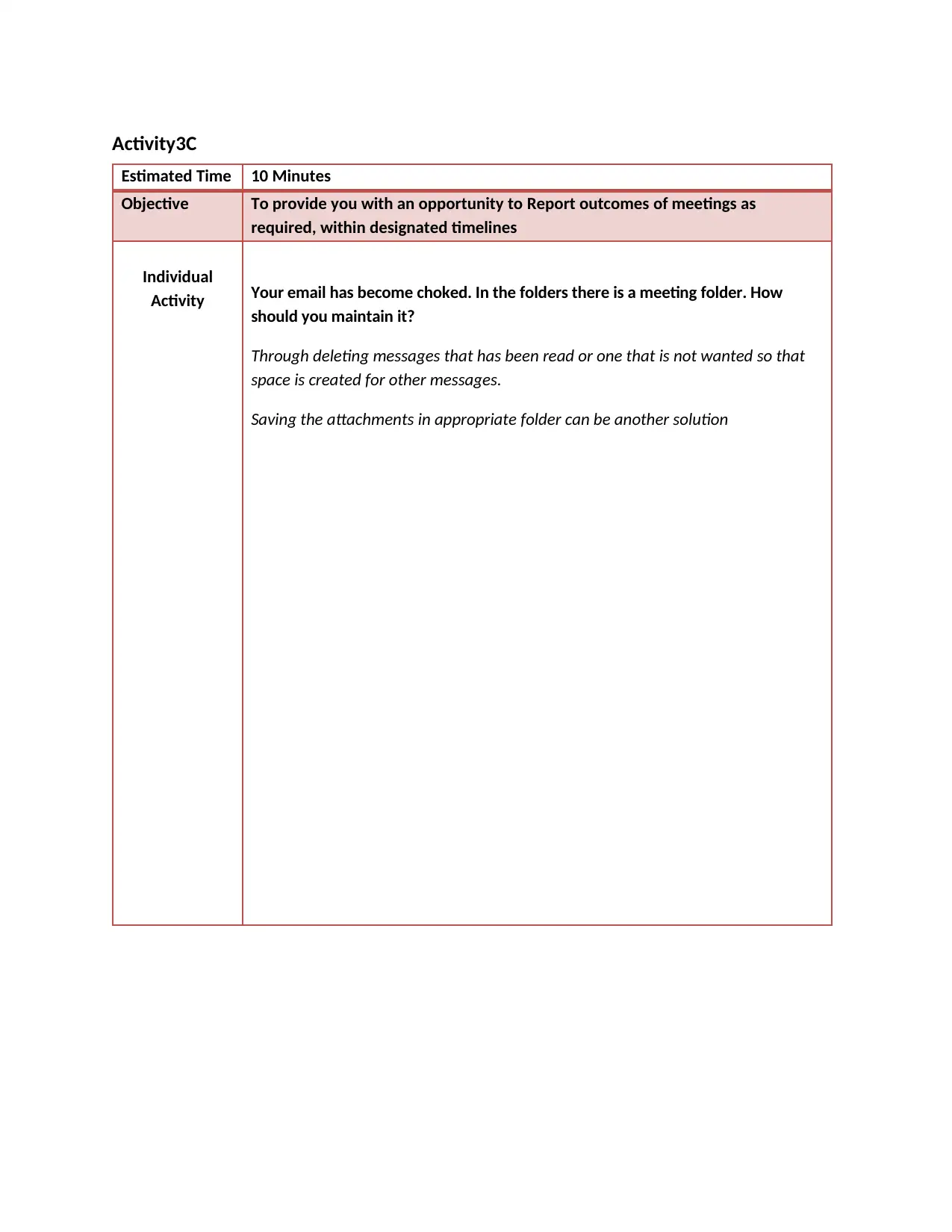
Activity3C
Estimated Time 10 Minutes
Objective To provide you with an opportunity to Report outcomes of meetings as
required, within designated timelines
Individual
Activity Your email has become choked. In the folders there is a meeting folder. How
should you maintain it?
Through deleting messages that has been read or one that is not wanted so that
space is created for other messages.
Saving the attachments in appropriate folder can be another solution
Estimated Time 10 Minutes
Objective To provide you with an opportunity to Report outcomes of meetings as
required, within designated timelines
Individual
Activity Your email has become choked. In the folders there is a meeting folder. How
should you maintain it?
Through deleting messages that has been read or one that is not wanted so that
space is created for other messages.
Saving the attachments in appropriate folder can be another solution
Paraphrase This Document
Need a fresh take? Get an instant paraphrase of this document with our AI Paraphraser
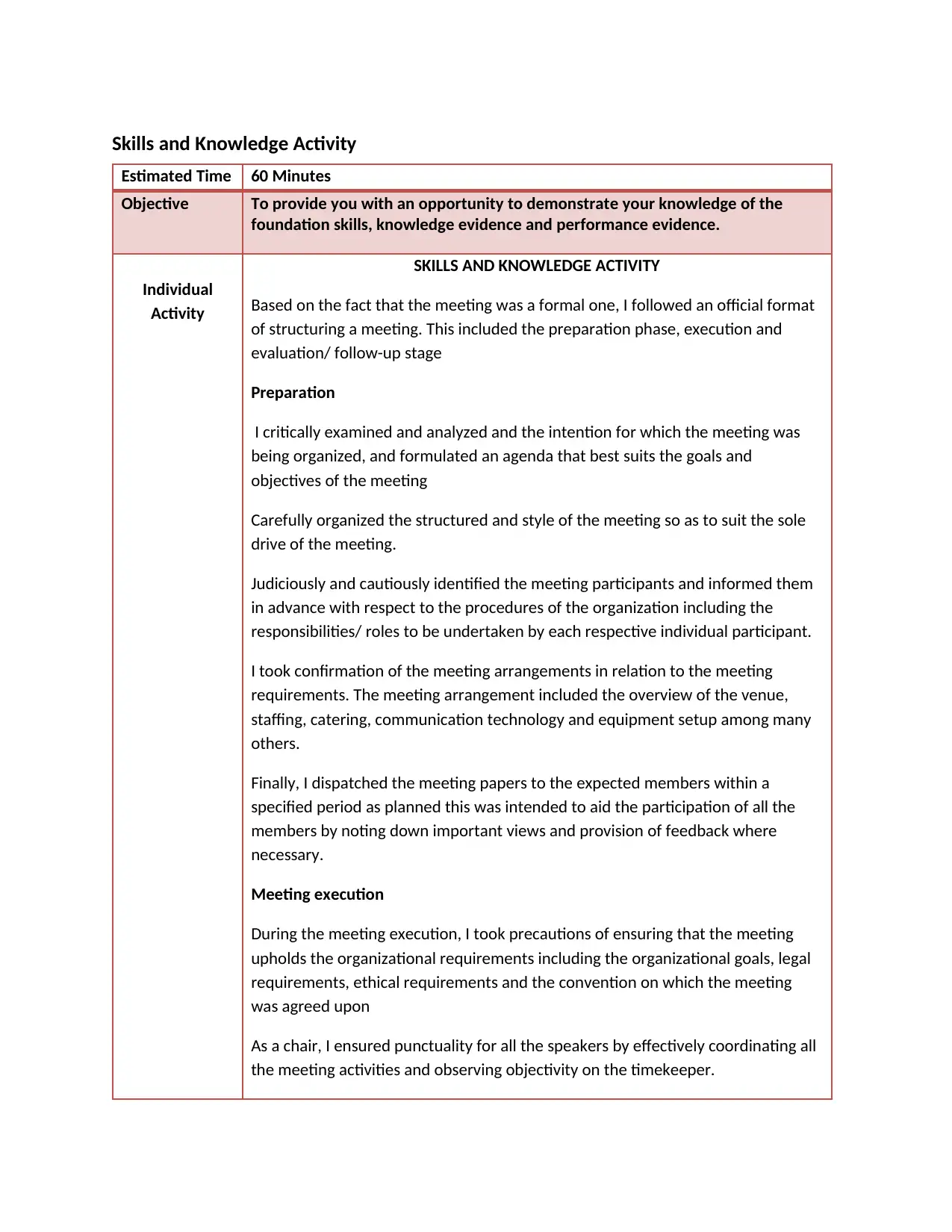
Skills and Knowledge Activity
Estimated Time 60 Minutes
Objective To provide you with an opportunity to demonstrate your knowledge of the
foundation skills, knowledge evidence and performance evidence.
Individual
Activity
SKILLS AND KNOWLEDGE ACTIVITY
Based on the fact that the meeting was a formal one, I followed an official format
of structuring a meeting. This included the preparation phase, execution and
evaluation/ follow-up stage
Preparation
I critically examined and analyzed and the intention for which the meeting was
being organized, and formulated an agenda that best suits the goals and
objectives of the meeting
Carefully organized the structured and style of the meeting so as to suit the sole
drive of the meeting.
Judiciously and cautiously identified the meeting participants and informed them
in advance with respect to the procedures of the organization including the
responsibilities/ roles to be undertaken by each respective individual participant.
I took confirmation of the meeting arrangements in relation to the meeting
requirements. The meeting arrangement included the overview of the venue,
staffing, catering, communication technology and equipment setup among many
others.
Finally, I dispatched the meeting papers to the expected members within a
specified period as planned this was intended to aid the participation of all the
members by noting down important views and provision of feedback where
necessary.
Meeting execution
During the meeting execution, I took precautions of ensuring that the meeting
upholds the organizational requirements including the organizational goals, legal
requirements, ethical requirements and the convention on which the meeting
was agreed upon
As a chair, I ensured punctuality for all the speakers by effectively coordinating all
the meeting activities and observing objectivity on the timekeeper.
Estimated Time 60 Minutes
Objective To provide you with an opportunity to demonstrate your knowledge of the
foundation skills, knowledge evidence and performance evidence.
Individual
Activity
SKILLS AND KNOWLEDGE ACTIVITY
Based on the fact that the meeting was a formal one, I followed an official format
of structuring a meeting. This included the preparation phase, execution and
evaluation/ follow-up stage
Preparation
I critically examined and analyzed and the intention for which the meeting was
being organized, and formulated an agenda that best suits the goals and
objectives of the meeting
Carefully organized the structured and style of the meeting so as to suit the sole
drive of the meeting.
Judiciously and cautiously identified the meeting participants and informed them
in advance with respect to the procedures of the organization including the
responsibilities/ roles to be undertaken by each respective individual participant.
I took confirmation of the meeting arrangements in relation to the meeting
requirements. The meeting arrangement included the overview of the venue,
staffing, catering, communication technology and equipment setup among many
others.
Finally, I dispatched the meeting papers to the expected members within a
specified period as planned this was intended to aid the participation of all the
members by noting down important views and provision of feedback where
necessary.
Meeting execution
During the meeting execution, I took precautions of ensuring that the meeting
upholds the organizational requirements including the organizational goals, legal
requirements, ethical requirements and the convention on which the meeting
was agreed upon
As a chair, I ensured punctuality for all the speakers by effectively coordinating all
the meeting activities and observing objectivity on the timekeeper.
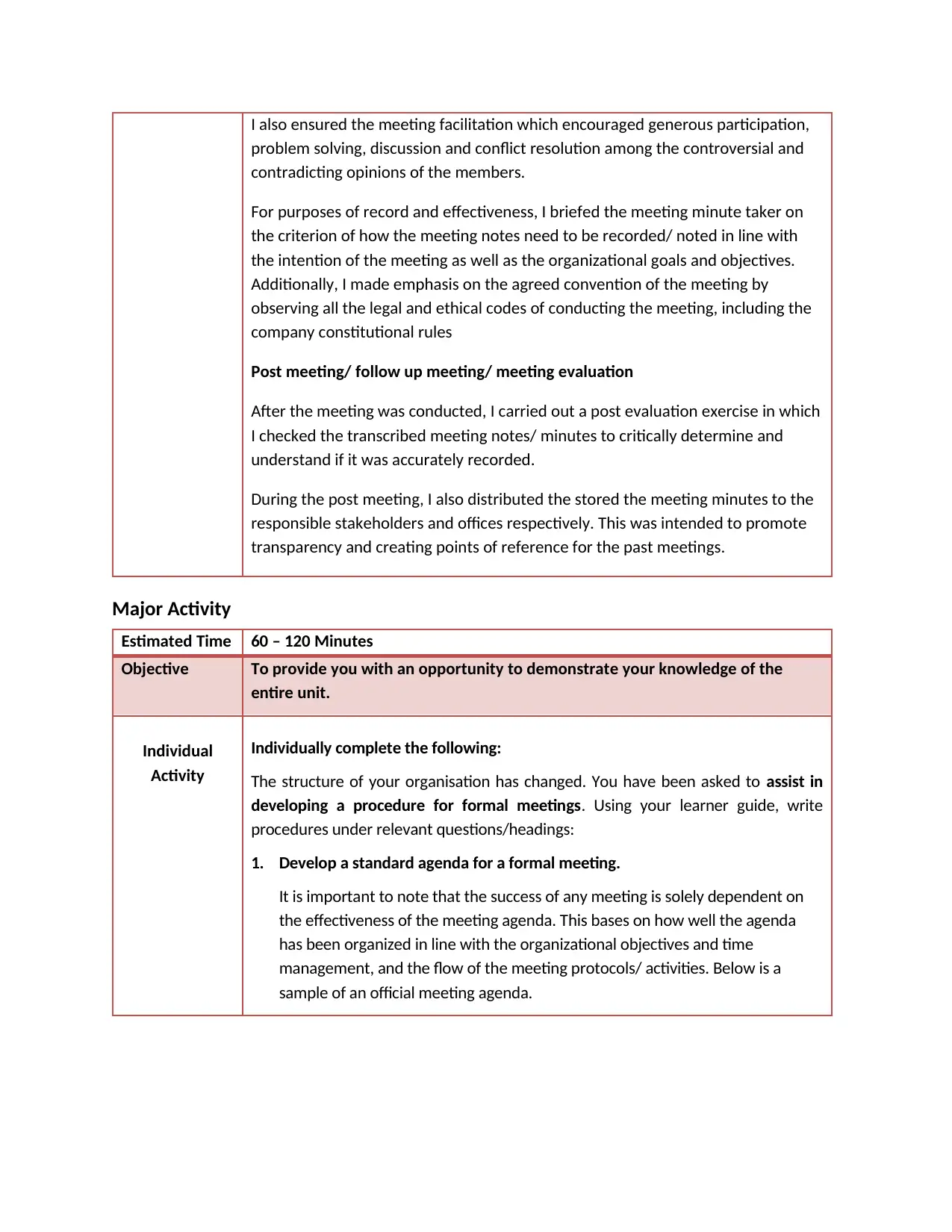
I also ensured the meeting facilitation which encouraged generous participation,
problem solving, discussion and conflict resolution among the controversial and
contradicting opinions of the members.
For purposes of record and effectiveness, I briefed the meeting minute taker on
the criterion of how the meeting notes need to be recorded/ noted in line with
the intention of the meeting as well as the organizational goals and objectives.
Additionally, I made emphasis on the agreed convention of the meeting by
observing all the legal and ethical codes of conducting the meeting, including the
company constitutional rules
Post meeting/ follow up meeting/ meeting evaluation
After the meeting was conducted, I carried out a post evaluation exercise in which
I checked the transcribed meeting notes/ minutes to critically determine and
understand if it was accurately recorded.
During the post meeting, I also distributed the stored the meeting minutes to the
responsible stakeholders and offices respectively. This was intended to promote
transparency and creating points of reference for the past meetings.
Major Activity
Estimated Time 60 – 120 Minutes
Objective To provide you with an opportunity to demonstrate your knowledge of the
entire unit.
Individual
Activity
Individually complete the following:
The structure of your organisation has changed. You have been asked to assist in
developing a procedure for formal meetings. Using your learner guide, write
procedures under relevant questions/headings:
1. Develop a standard agenda for a formal meeting.
It is important to note that the success of any meeting is solely dependent on
the effectiveness of the meeting agenda. This bases on how well the agenda
has been organized in line with the organizational objectives and time
management, and the flow of the meeting protocols/ activities. Below is a
sample of an official meeting agenda.
problem solving, discussion and conflict resolution among the controversial and
contradicting opinions of the members.
For purposes of record and effectiveness, I briefed the meeting minute taker on
the criterion of how the meeting notes need to be recorded/ noted in line with
the intention of the meeting as well as the organizational goals and objectives.
Additionally, I made emphasis on the agreed convention of the meeting by
observing all the legal and ethical codes of conducting the meeting, including the
company constitutional rules
Post meeting/ follow up meeting/ meeting evaluation
After the meeting was conducted, I carried out a post evaluation exercise in which
I checked the transcribed meeting notes/ minutes to critically determine and
understand if it was accurately recorded.
During the post meeting, I also distributed the stored the meeting minutes to the
responsible stakeholders and offices respectively. This was intended to promote
transparency and creating points of reference for the past meetings.
Major Activity
Estimated Time 60 – 120 Minutes
Objective To provide you with an opportunity to demonstrate your knowledge of the
entire unit.
Individual
Activity
Individually complete the following:
The structure of your organisation has changed. You have been asked to assist in
developing a procedure for formal meetings. Using your learner guide, write
procedures under relevant questions/headings:
1. Develop a standard agenda for a formal meeting.
It is important to note that the success of any meeting is solely dependent on
the effectiveness of the meeting agenda. This bases on how well the agenda
has been organized in line with the organizational objectives and time
management, and the flow of the meeting protocols/ activities. Below is a
sample of an official meeting agenda.
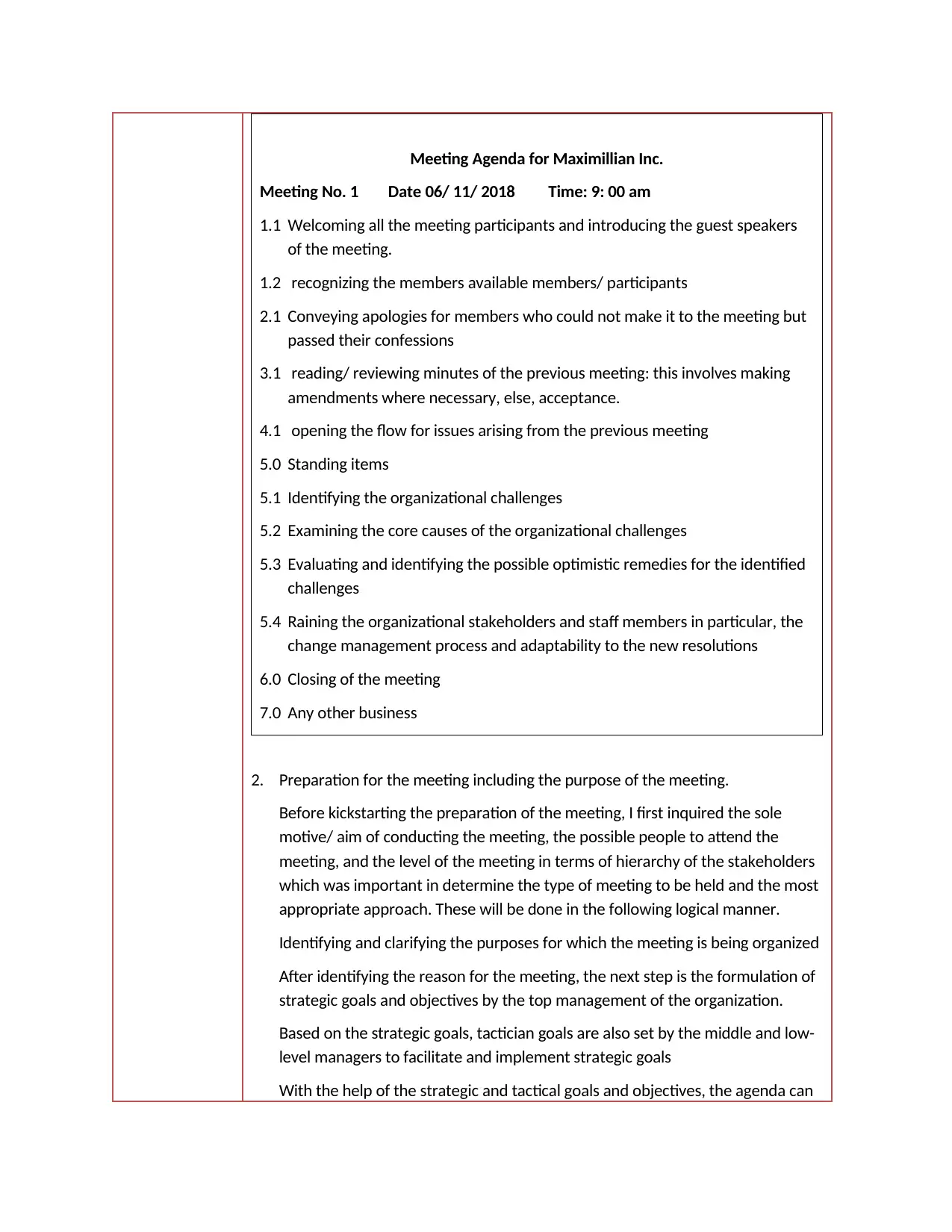
Meeting Agenda for Maximillian Inc.
Meeting No. 1 Date 06/ 11/ 2018 Time: 9: 00 am
1.1 Welcoming all the meeting participants and introducing the guest speakers
of the meeting.
1.2 recognizing the members available members/ participants
2.1 Conveying apologies for members who could not make it to the meeting but
passed their confessions
3.1 reading/ reviewing minutes of the previous meeting: this involves making
amendments where necessary, else, acceptance.
4.1 opening the flow for issues arising from the previous meeting
5.0 Standing items
5.1 Identifying the organizational challenges
5.2 Examining the core causes of the organizational challenges
5.3 Evaluating and identifying the possible optimistic remedies for the identified
challenges
5.4 Raining the organizational stakeholders and staff members in particular, the
change management process and adaptability to the new resolutions
6.0 Closing of the meeting
7.0 Any other business
2. Preparation for the meeting including the purpose of the meeting.
Before kickstarting the preparation of the meeting, I first inquired the sole
motive/ aim of conducting the meeting, the possible people to attend the
meeting, and the level of the meeting in terms of hierarchy of the stakeholders
which was important in determine the type of meeting to be held and the most
appropriate approach. These will be done in the following logical manner.
Identifying and clarifying the purposes for which the meeting is being organized
After identifying the reason for the meeting, the next step is the formulation of
strategic goals and objectives by the top management of the organization.
Based on the strategic goals, tactician goals are also set by the middle and low-
level managers to facilitate and implement strategic goals
With the help of the strategic and tactical goals and objectives, the agenda can
Meeting No. 1 Date 06/ 11/ 2018 Time: 9: 00 am
1.1 Welcoming all the meeting participants and introducing the guest speakers
of the meeting.
1.2 recognizing the members available members/ participants
2.1 Conveying apologies for members who could not make it to the meeting but
passed their confessions
3.1 reading/ reviewing minutes of the previous meeting: this involves making
amendments where necessary, else, acceptance.
4.1 opening the flow for issues arising from the previous meeting
5.0 Standing items
5.1 Identifying the organizational challenges
5.2 Examining the core causes of the organizational challenges
5.3 Evaluating and identifying the possible optimistic remedies for the identified
challenges
5.4 Raining the organizational stakeholders and staff members in particular, the
change management process and adaptability to the new resolutions
6.0 Closing of the meeting
7.0 Any other business
2. Preparation for the meeting including the purpose of the meeting.
Before kickstarting the preparation of the meeting, I first inquired the sole
motive/ aim of conducting the meeting, the possible people to attend the
meeting, and the level of the meeting in terms of hierarchy of the stakeholders
which was important in determine the type of meeting to be held and the most
appropriate approach. These will be done in the following logical manner.
Identifying and clarifying the purposes for which the meeting is being organized
After identifying the reason for the meeting, the next step is the formulation of
strategic goals and objectives by the top management of the organization.
Based on the strategic goals, tactician goals are also set by the middle and low-
level managers to facilitate and implement strategic goals
With the help of the strategic and tactical goals and objectives, the agenda can
Secure Best Marks with AI Grader
Need help grading? Try our AI Grader for instant feedback on your assignments.
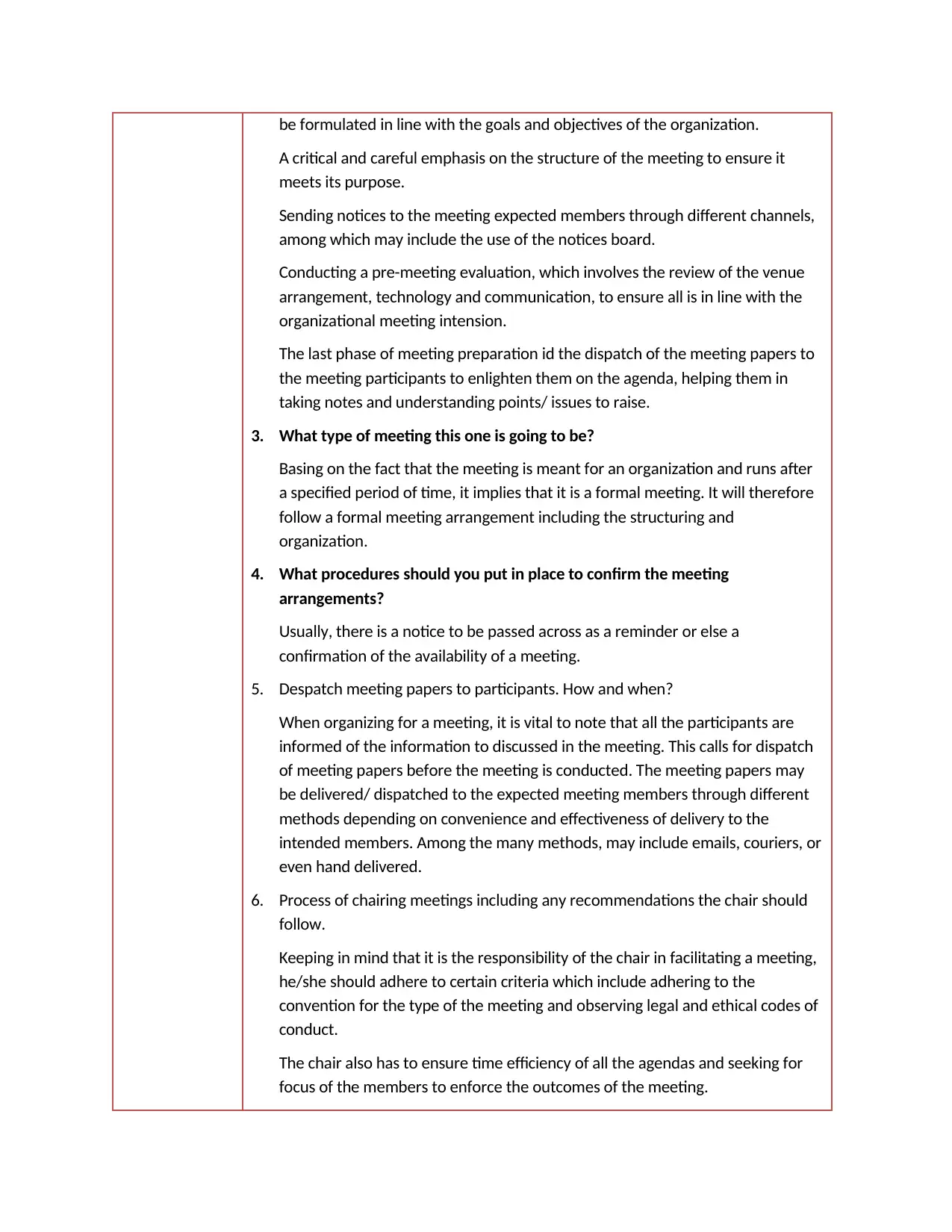
be formulated in line with the goals and objectives of the organization.
A critical and careful emphasis on the structure of the meeting to ensure it
meets its purpose.
Sending notices to the meeting expected members through different channels,
among which may include the use of the notices board.
Conducting a pre-meeting evaluation, which involves the review of the venue
arrangement, technology and communication, to ensure all is in line with the
organizational meeting intension.
The last phase of meeting preparation id the dispatch of the meeting papers to
the meeting participants to enlighten them on the agenda, helping them in
taking notes and understanding points/ issues to raise.
3. What type of meeting this one is going to be?
Basing on the fact that the meeting is meant for an organization and runs after
a specified period of time, it implies that it is a formal meeting. It will therefore
follow a formal meeting arrangement including the structuring and
organization.
4. What procedures should you put in place to confirm the meeting
arrangements?
Usually, there is a notice to be passed across as a reminder or else a
confirmation of the availability of a meeting.
5. Despatch meeting papers to participants. How and when?
When organizing for a meeting, it is vital to note that all the participants are
informed of the information to discussed in the meeting. This calls for dispatch
of meeting papers before the meeting is conducted. The meeting papers may
be delivered/ dispatched to the expected meeting members through different
methods depending on convenience and effectiveness of delivery to the
intended members. Among the many methods, may include emails, couriers, or
even hand delivered.
6. Process of chairing meetings including any recommendations the chair should
follow.
Keeping in mind that it is the responsibility of the chair in facilitating a meeting,
he/she should adhere to certain criteria which include adhering to the
convention for the type of the meeting and observing legal and ethical codes of
conduct.
The chair also has to ensure time efficiency of all the agendas and seeking for
focus of the members to enforce the outcomes of the meeting.
A critical and careful emphasis on the structure of the meeting to ensure it
meets its purpose.
Sending notices to the meeting expected members through different channels,
among which may include the use of the notices board.
Conducting a pre-meeting evaluation, which involves the review of the venue
arrangement, technology and communication, to ensure all is in line with the
organizational meeting intension.
The last phase of meeting preparation id the dispatch of the meeting papers to
the meeting participants to enlighten them on the agenda, helping them in
taking notes and understanding points/ issues to raise.
3. What type of meeting this one is going to be?
Basing on the fact that the meeting is meant for an organization and runs after
a specified period of time, it implies that it is a formal meeting. It will therefore
follow a formal meeting arrangement including the structuring and
organization.
4. What procedures should you put in place to confirm the meeting
arrangements?
Usually, there is a notice to be passed across as a reminder or else a
confirmation of the availability of a meeting.
5. Despatch meeting papers to participants. How and when?
When organizing for a meeting, it is vital to note that all the participants are
informed of the information to discussed in the meeting. This calls for dispatch
of meeting papers before the meeting is conducted. The meeting papers may
be delivered/ dispatched to the expected meeting members through different
methods depending on convenience and effectiveness of delivery to the
intended members. Among the many methods, may include emails, couriers, or
even hand delivered.
6. Process of chairing meetings including any recommendations the chair should
follow.
Keeping in mind that it is the responsibility of the chair in facilitating a meeting,
he/she should adhere to certain criteria which include adhering to the
convention for the type of the meeting and observing legal and ethical codes of
conduct.
The chair also has to ensure time efficiency of all the agendas and seeking for
focus of the members to enforce the outcomes of the meeting.
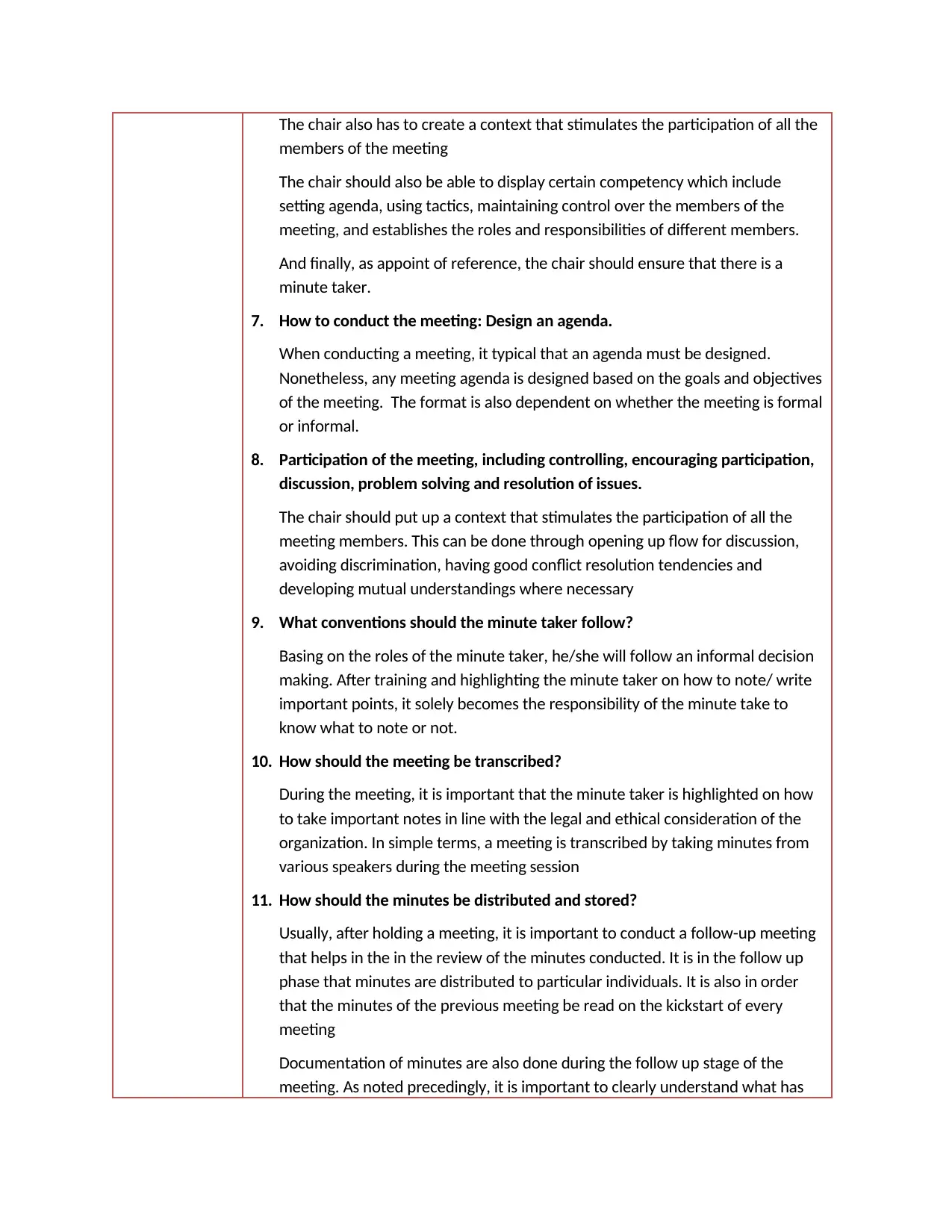
The chair also has to create a context that stimulates the participation of all the
members of the meeting
The chair should also be able to display certain competency which include
setting agenda, using tactics, maintaining control over the members of the
meeting, and establishes the roles and responsibilities of different members.
And finally, as appoint of reference, the chair should ensure that there is a
minute taker.
7. How to conduct the meeting: Design an agenda.
When conducting a meeting, it typical that an agenda must be designed.
Nonetheless, any meeting agenda is designed based on the goals and objectives
of the meeting. The format is also dependent on whether the meeting is formal
or informal.
8. Participation of the meeting, including controlling, encouraging participation,
discussion, problem solving and resolution of issues.
The chair should put up a context that stimulates the participation of all the
meeting members. This can be done through opening up flow for discussion,
avoiding discrimination, having good conflict resolution tendencies and
developing mutual understandings where necessary
9. What conventions should the minute taker follow?
Basing on the roles of the minute taker, he/she will follow an informal decision
making. After training and highlighting the minute taker on how to note/ write
important points, it solely becomes the responsibility of the minute take to
know what to note or not.
10. How should the meeting be transcribed?
During the meeting, it is important that the minute taker is highlighted on how
to take important notes in line with the legal and ethical consideration of the
organization. In simple terms, a meeting is transcribed by taking minutes from
various speakers during the meeting session
11. How should the minutes be distributed and stored?
Usually, after holding a meeting, it is important to conduct a follow-up meeting
that helps in the in the review of the minutes conducted. It is in the follow up
phase that minutes are distributed to particular individuals. It is also in order
that the minutes of the previous meeting be read on the kickstart of every
meeting
Documentation of minutes are also done during the follow up stage of the
meeting. As noted precedingly, it is important to clearly understand what has
members of the meeting
The chair should also be able to display certain competency which include
setting agenda, using tactics, maintaining control over the members of the
meeting, and establishes the roles and responsibilities of different members.
And finally, as appoint of reference, the chair should ensure that there is a
minute taker.
7. How to conduct the meeting: Design an agenda.
When conducting a meeting, it typical that an agenda must be designed.
Nonetheless, any meeting agenda is designed based on the goals and objectives
of the meeting. The format is also dependent on whether the meeting is formal
or informal.
8. Participation of the meeting, including controlling, encouraging participation,
discussion, problem solving and resolution of issues.
The chair should put up a context that stimulates the participation of all the
meeting members. This can be done through opening up flow for discussion,
avoiding discrimination, having good conflict resolution tendencies and
developing mutual understandings where necessary
9. What conventions should the minute taker follow?
Basing on the roles of the minute taker, he/she will follow an informal decision
making. After training and highlighting the minute taker on how to note/ write
important points, it solely becomes the responsibility of the minute take to
know what to note or not.
10. How should the meeting be transcribed?
During the meeting, it is important that the minute taker is highlighted on how
to take important notes in line with the legal and ethical consideration of the
organization. In simple terms, a meeting is transcribed by taking minutes from
various speakers during the meeting session
11. How should the minutes be distributed and stored?
Usually, after holding a meeting, it is important to conduct a follow-up meeting
that helps in the in the review of the minutes conducted. It is in the follow up
phase that minutes are distributed to particular individuals. It is also in order
that the minutes of the previous meeting be read on the kickstart of every
meeting
Documentation of minutes are also done during the follow up stage of the
meeting. As noted precedingly, it is important to clearly understand what has
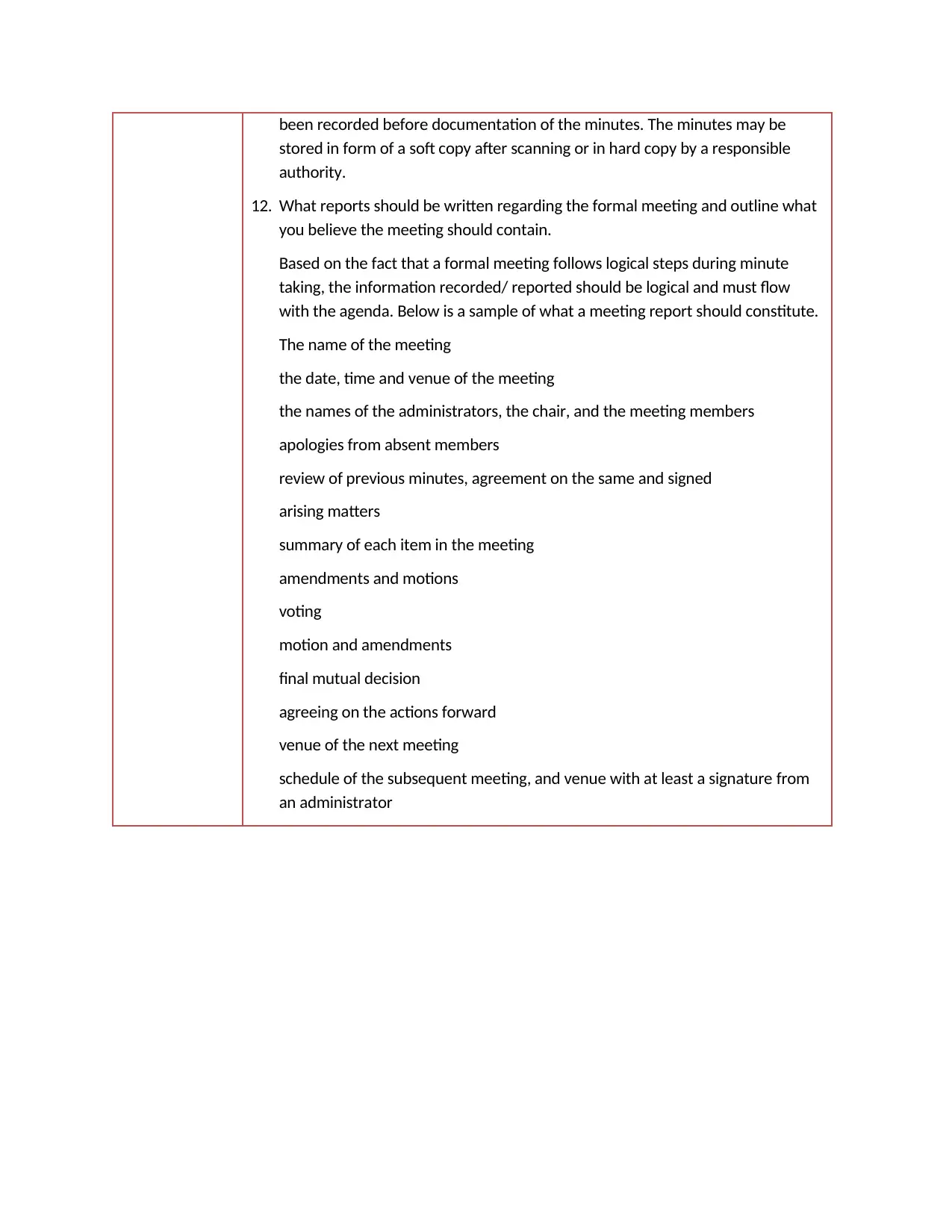
been recorded before documentation of the minutes. The minutes may be
stored in form of a soft copy after scanning or in hard copy by a responsible
authority.
12. What reports should be written regarding the formal meeting and outline what
you believe the meeting should contain.
Based on the fact that a formal meeting follows logical steps during minute
taking, the information recorded/ reported should be logical and must flow
with the agenda. Below is a sample of what a meeting report should constitute.
The name of the meeting
the date, time and venue of the meeting
the names of the administrators, the chair, and the meeting members
apologies from absent members
review of previous minutes, agreement on the same and signed
arising matters
summary of each item in the meeting
amendments and motions
voting
motion and amendments
final mutual decision
agreeing on the actions forward
venue of the next meeting
schedule of the subsequent meeting, and venue with at least a signature from
an administrator
stored in form of a soft copy after scanning or in hard copy by a responsible
authority.
12. What reports should be written regarding the formal meeting and outline what
you believe the meeting should contain.
Based on the fact that a formal meeting follows logical steps during minute
taking, the information recorded/ reported should be logical and must flow
with the agenda. Below is a sample of what a meeting report should constitute.
The name of the meeting
the date, time and venue of the meeting
the names of the administrators, the chair, and the meeting members
apologies from absent members
review of previous minutes, agreement on the same and signed
arising matters
summary of each item in the meeting
amendments and motions
voting
motion and amendments
final mutual decision
agreeing on the actions forward
venue of the next meeting
schedule of the subsequent meeting, and venue with at least a signature from
an administrator
1 out of 13
Related Documents
Your All-in-One AI-Powered Toolkit for Academic Success.
+13062052269
info@desklib.com
Available 24*7 on WhatsApp / Email
![[object Object]](/_next/static/media/star-bottom.7253800d.svg)
Unlock your academic potential
© 2024 | Zucol Services PVT LTD | All rights reserved.





